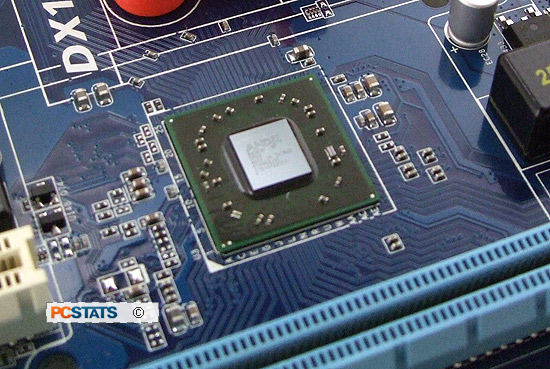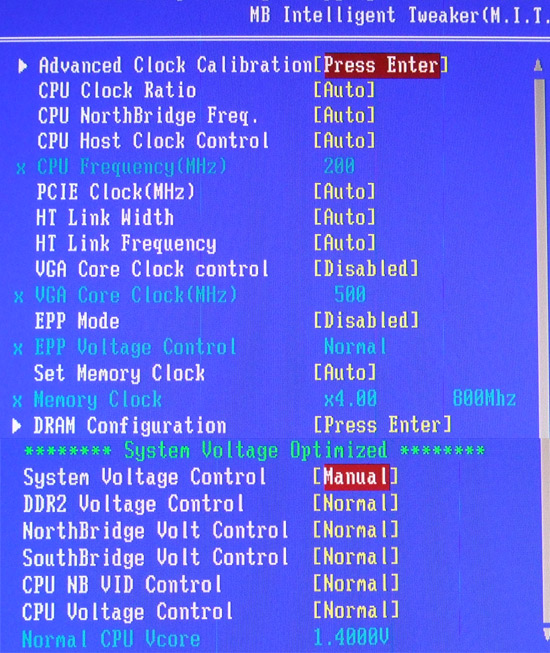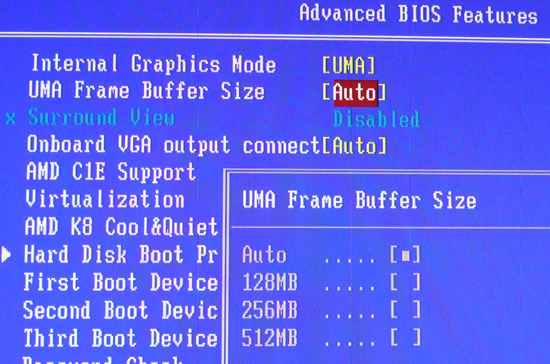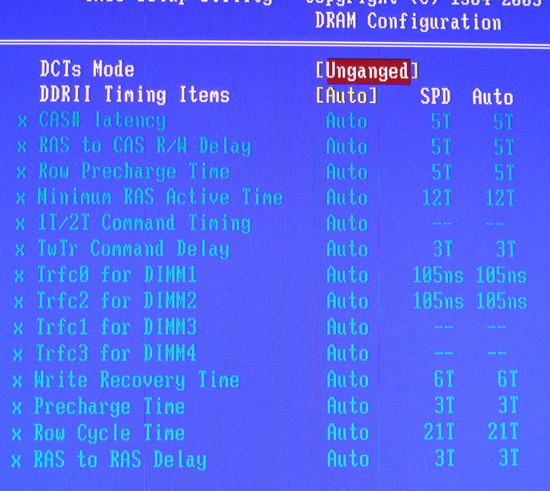 |
| Overclocking Results: |
|
|
Unlike
most integrated motherboards PCSTATS has reviewed, ATI has enabled IGP
overclocking with the AMD 785G chipset. The default clock is 500MHz, so it will
be interesting to see what impact a 200-250MHz overclock will have on IGP
performance.... anyway's let's begin.
As
always, overclocking starts off by dropping the multiplier on the AMD Phenom II
x4 955 Black Edition down to 8x, disabling features like Cool'n'quiet and CPU
C1E power states. A set of DDR2-1600MHz memory modules from Corsair was locked
into the Gigabyte GA-MA785GMT-UD3H and set to run in DDR2-800MHz mode so it
wouldn't hold the CPU back - in this first test we're trying to find the highest
support bus speed.
The bus
speed of the Gigabyte GA-MA785G-UD3H motherboard was then bumped up from 200MHz
to 250MHz.... and 275MHz which caused the system to crash while loading Windows
Vista. A megahertz too far? After a bit of fiddling, the bus speed was reduced
to 265MHz, allowing Vista to boot properly. Not the best overclock PCSTATS has
squeezed from an AMD 785G board, but not too shabby.
Integrated Graphics Overclocking
 After finishing with the CPU, PCSTATS
turned its attention to overclocking the AMD Radeon HD 4200 IGP. The ability to
overclock and integrated video chipset is relatively new, and the results can
boost performance a little.
After finishing with the CPU, PCSTATS
turned its attention to overclocking the AMD Radeon HD 4200 IGP. The ability to
overclock and integrated video chipset is relatively new, and the results can
boost performance a little.
The Radeon HD 4200 IGP is clocked at 500MHz by default.
Overclocking from 500MHz to 650MHz was easy, and pushing the AMD785G IGP to
725MHz wasn't hard at all. In a matter of minutes the IGP was operating at
775MHz without difficulty.
Once the Radeon HD 4200 IGP was overclocked, it was only
natural for PCSTATS to run some quick benchmarks to see what kind of performance
gains were actually achieved.
The default 3Dmark 06 benchmark result for this board
(IGP @ 500MHz) is 1686 3DMarks.
Overclocking the Radeon HD 4200 IGP from 500MHz to 775MHz improved this
benchmark score to 2098 3Dmarks.
It's interesting to compare these results against the
ASUS M4A785TD-V EVO motherboard, its IGP overclocked to 750MHz, but incorporates
128MB of SidePort memory which the Gigabyte GA-MA785G-UD3H motherboard does not.
The overclocked ASUS managed an overclocked score of 2308 3DMarks. The difference is due to the 128MB
of DDR3 1333MHz SidePort memory, which increases performance in 3D loaded
benchmarks like this.
Inside the BIOS

Gigabyte's main system settings BIOS page allows for
both manual and automatic overclocking, as well as voltage control over the
Gigabyte GA-MA785G-UD3H's CPU, AMD 785G northbridge, and DDR2 memory.

The Radeon HD 4200 IGP's video memory can be expanded
through the BIOS as well. Increasing the memory buffer will improve graphics
performance, at the expense of having less system memory available.

The core clock of the Radeon HD 4200 IGP can be
overclocked easily by keying in the speed here. Radeon 3xxx and 4xxx-series IGPs
tends to be very good overclockers, although even when overclocked their 3D
performance is limited.

Memory timings can be adjust by clock cycle, which makes
it possible to tweak timings to their tightest possible settings. Since this
motherboard supports low-latency DDR2, it's especially important to get the most
efficient timings possible.
Measuring Energy Efficiency
Energy
efficient computers are a good thing, so it helps to know how power efficient,
or power hungry different parts of a computer are when stressed with different
tasks. Since it is very difficult to isolate a videocard or CPU and measure
power draw separately, PCSTATS measures total system power draw with the aid of
an Extech 380803 AC Power Analyzer and A-PFC compliant PC Power and Cooling 750W power supply. The meter is
placed between the 120V AC outlet and the PC power supply. By stressing the test
platform's graphics solution or processor, it's then possible to measure power
draw relative to the PC at an idle state.
The test
system is measured at Idle (Windows desktop), Graphics Loaded (3Dmark06) and CPU
Loaded (Prime 95) states.
|
Total System Power Draw
 Gigabyte
GA-MA785G-UD3H Gigabyte
GA-MA785G-UD3H |
|
Graphics Solution |
Idle
|
Graphics
Loaded |
CPU
Loaded |
|
AMD HD
4200
(Integrated Graphics) |
110W |
147W |
198W |
|
nVidia Geforce GTS250
(Discrete Graphics)
|
160W |
284W |
260W |
|
(At desktop) |
(via 3Dmark 06) |
(via
Prime95) | |
AMD's Radeon HD 4200 IGP still has a fairly small
TDP, so when running in integrated graphics with a low-wattage AMD CPU the
Gigabyte GA-MA785G-UD3H doesn't have much trouble keeping under 150W. Discrete
graphics predictably increase total system power draw to 198W.
All seems well with the GA-MA785G-UD3H so far.... next
up - benchmarks!
